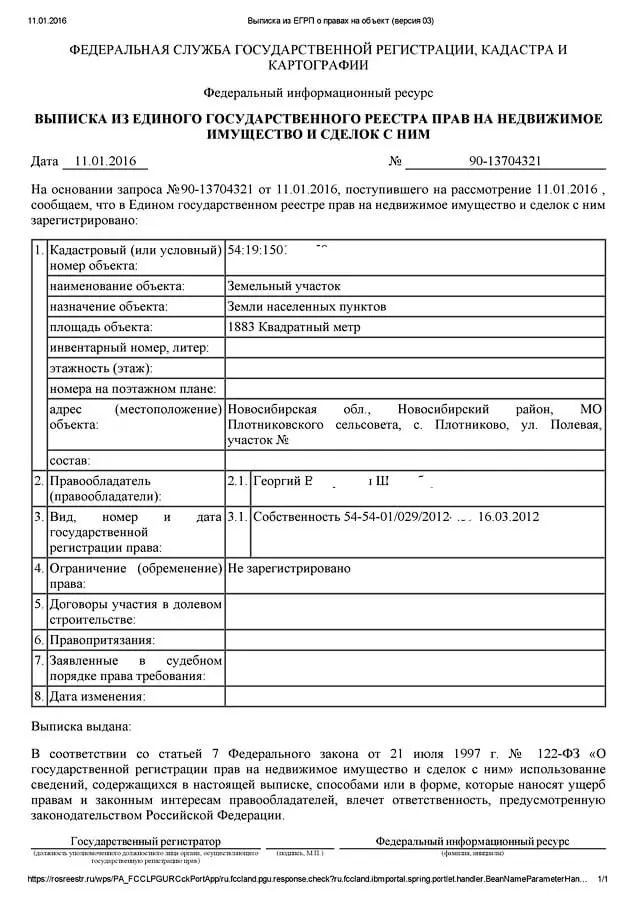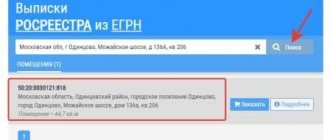Currently, the law establishes the obligation to record all real estate objects in one Register. It contains complete information about all registered real estate, including land plots.
The USRN information databases store data on the cadastre and rights to the object. In addition to many characteristics and information, the cadastral block contains a unique number, and the legal block reflects information about the owner of a specific land plot. Therefore, knowing its cadastral number, you can clarify the legal owner, his last name, first name and patronymic.
Most often this is in demand:
- If you need to find out if the land that you would like to get for yourself is abandoned. Let’s say that the territory of a neighboring plot has not been used by anyone for a long time, and someone plans to annex this land to their own.
- And also in the case of a purchase, when you want to clarify, the owner sells the land himself or through an intermediary.
- In addition, you can find out how many people are the owners, whether there are encumbrances, whether there are minor citizens among the owners, etc.
You can obtain this information by ordering an extract from the Unified State Register. This document contains complete information specified at the time of registration of the site. A document is issued, both electronically and in paper form, only at the request of the interested party.
How to find out the owner of a land plot by cadastral number
There is a clever way to find out the owner through the Avito message board. Enter the cadastral number in the Avito search line and you will find the owner’s advertisement if he posted it earlier.
If the exact cadastral number is unknown, then you can find it out for free by knowing the address of the property - read the detailed instructions. When it is found, the reference information must contain brief data, including the cadastral number. But there is no information about the copyright holder there, since this information is issued only upon request and in the form of an extract, which indicates all the data on the plot contained in the Rosreestr databases:
- Owner's full name;
- permitted use;
- what category of land does this site belong to;
- square;
- address;
- cost, etc.
Let us clarify that an extract from the Unified State Register of Real Estate will give you an idea not only of the general parameters, but also of whether the land is collateral, whether there are any encumbrances against it, or whether it has been seized. This will help save your nerves and money from the actions of unscrupulous realtors and owners who want to sell it.
The service of obtaining an extract is not free. The applicant is required to pay a state fee, the amount of which differs from the legal status of the person: an individual pays 250 rubles, a legal entity – 950 rubles.
You can order an extract in several ways, including without leaving your home:
- Upon personal appearance at the Rosreestr office.
- Visiting the MFC.
- Order on the website online.
- By sending a request by mail.
- Ordering field service.
The response time will be approximately 3 business days after registration of the request. Let's look at each method in more detail.
At the Rosreestr branch
When visiting in person you will need to provide the following documents:
- citizen's passport;
- payment document confirming payment of state duty;
- an application that is filled out according to the approved template directly at the office of the government agency.
You will need to indicate the cadastral number on the application form so that the plot can be identified and your request can be answered.
The documents are accepted by an employee of Rosreestr, and a receipt with the appropriate mark is issued. On the set date you need to come to the department again for an extract.
In the department of the Multifunctional Center
Contacting the MFC is similar to the previous one, since such centers are intermediaries between citizens and government agencies. The processing time for the request in this case may increase by 2 business days, which is due to the transfer of papers to Rosreestr and receipt of a response.
Electronic form online
The most convenient way to receive an extract for many is electronically. The advantage is that you submit it directly from home online, quickly and easily fill out the form, and respond in electronic form, which is legally equal to the paper version with a stamp.
You only need to enter the cadastral number into the search line and the system will find the desired plot.
After payment, an electronic extract from the Unified State Register will be sent to your email address within 24 hours.
Order an extract from the Unified State Register of Real Estate
By mail
You can also receive an extract via Russian Post. This is convenient for residents of those areas that are located far from the branches of Rosreestr and the MFC. The letter should include a completed application, a copy of your passport certified by a notary, and a list of attachments. It is better to send it with a notification to ensure receipt by the addressee.
The timing of receiving a response directly depends on the work of the mailers. Therefore, you can expect a response within 1-2 weeks.
Field service
Required by phone. order this service. At the request of the applicant, a specialist from Rosreestr or the MFC goes to his home and fills out an application. This service can be used free of charge only by a few categories of citizens, which include disabled people of groups I and II, as well as veterans and disabled people of the Great Patriotic War.
Reasons for seeking information
As a rule, land buyers want to receive information from the Unified State Register of Real Estate in order to check whether the seller has ownership rights. Of course, the seller can show a certificate or a recent extract, but for greater confidence the buyer can order an extract himself: the information contained in the Unified State Register of Real Estate about the ownership of the plot is open and can be provided upon request, paid with a state fee.
Another reason is the desire to lease or buy a plot of land, which is probably in state or municipal ownership, but may also be privately owned. Often such plots, apparently ownerless, are found in gardening enterprises that have ceased operating as legal entities. If the dacha cooperative is functioning, the chairman of the cooperative can use his documents to determine to whom the plot was allocated and whether fees are paid for its use, but it is best to obtain official information about rights from Rosreestr.
We recommend that you read:
How to obtain a cadastral passport for an apartment through State Services and Rosreestr
An encumbrance, which is a restriction on the turnover of a thing, can be established for the purpose of mortgage lending. If the property was purchased with a mortgage loan, then when signing the purchase and sale agreement, the mortgage note was also submitted for registration in favor of the bank.
The encumbrance does not prohibit the sale of the plot as such, but only makes it dependent on the consent of the creditor.
It happens that the original borrower wants to sell the mortgaged property, and the buyer is ready to assume the responsibilities of the borrower or even buy the mortgage in a single payment.
In the second case, banks are willing to meet halfway; in the first, they can also agree to transfer the debt if they consider the new borrower to be no less solvent than the old one. The basis for acquiring ownership is important to determine the independence of the seller relative to his (her) spouse. In other words, can the seller sell the plot without the consent of the wife (husband). If the seller received the plot as a gift or by inheritance, the consent of the spouse will not be required; in other cases, it may be needed if the plot was acquired during marriage.
Changes concerning the site are made to the Unified State Register very quickly: within 7 working days for transactions in simple written form and 3 days for notarized ones. Therefore, a fresh extract from the Unified State Register of Real Estate confirms with almost a 100% guarantee the rights of the person whose name is entered in the owner’s column.
Thanks to an extract from the Unified State Register of Real Estate, you can independently prepare a purchase and sale agreement, since it allows you to indicate the following features as uniquely defining the plot:
- Address.
- Cadastral number.
- Square.
Usually these three points are enough for the agreement to be registered, but sometimes registrars ask to indicate the category of land and the type of permitted use, so you can enter them into the agreement in advance by filling out an extract. Minor deficiencies in the contract do not give the right to refuse registration; in these cases, the registrar requests updated contracts.
How to find out the owner of a land plot by address
It is not always possible to find out the cadastral number of a plot, then the owner can be calculated by the exact address of the land plot. There are several ways to do this:
- Order an extract from the Unified State Register of Real Estate. The most reliable and fastest way to find out the owner of a plot without leaving your home.

Order an extract from the Unified State Register of Real Estate - Contact the territorial tax office at the location of the site. At the same time, you will be required to explain why you need such information.
- Check with your local administration for details. If this land turns out to be municipal, the administration will provide the information. In the case of a registered right for a private person, they will refuse.
- If the land plot is part of a gardening cooperative or partnership, you can ask the chairman for information about its owner. He keeps log books containing information about whose plot this is, as well as other data on a specific plot.
The Rosreestr authority may refuse to issue information about the owner of a land plot for several reasons:
- there is no registration in the cadastre, that is, there is no record of its existence and owner;
- the application is filled out incorrectly when errors are made or information is incomplete.
What documents confirm ownership?
To find out this information, you need an extract from the Unified State Register for the area of interest. The official name is “an extract from the Unified State Register of Real Estate on the main characteristics and registered rights to the property.” In our case, a real estate object is a land plot.
In practice, situations often arise when the area of the plot indicated in the title document is smaller than it actually is. It is important to know that even in this case, Rosreestr authorities do not have the right to refuse state registration.
The indication of the area may indicate “Specified area”, this means that land surveying has been carried out. If “Declared area” is indicated, then land surveying still needs to be done.
In addition to the public map itself, other maps that have access to data updates via satellite surveillance will come to the rescue. For example, Google Maps. Through this map you can find out the actual real image of the area, find out whether there are buildings in certain areas.
However, tax officials are not always willing to help and provide the information of interest, so the interested party will have to submit a petition with detailed arguments for the need to obtain information about the owner.
This will help you decide in which zone to start searching, based on the purposes for which the site is needed. Thus, private individuals can only claim land for individual housing construction or agricultural land. Other categories cannot be transferred to private ownership. They can only be rented.
The attached document must be digitally signed by the applicant and a file signed with digital signature must be attached.
With all the punitive measures traditionally provided for in official documents by the currently used 1998 law “On gardening, gardening and dacha non-profit associations of citizens”, the concepts of deprivation of a plot are very vaguely spelled out in it.
This is important to know: What is a local area according to the Housing Code
In these cases, privatization of a land plot requires additional time and financial costs. The process of registering property may be especially lengthy in the latter case. Initially, to register common property, it is necessary to make a decision at a general meeting of members of the society and submit the appropriate collective application to the territorial administration.
The territorial administration must, within 1 month from the date of filing the application, issue an order to provide the land into public ownership and approve the boundary plan. This order serves as the basis for further land surveying of both the common plot as a whole and each individual plot of land separately.
- Collection of documentation and its transfer;
- Waiting for the results of the decision made (the period during which the issue is considered and documents are studied is two weeks);
- If there is no cadastral plan, specialists must carry out a set of works related to visiting the land plot to specifically determine and fix the lines of its boundaries;
- Receiving a specific decision (if approved) that a land plot is being transferred to a citizen for personal use;
- Carrying out land surveying work, establishing boundary lines and creating a cadastral plan;
- Redirection of the prepared cadastral map by a specialist to a specific cadastre department;
- Concluding a specific transaction (for example, purchase/sale) or signing an agreement that the transfer of a land plot into the possession of a person is carried out without payment.









